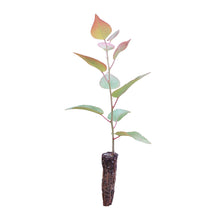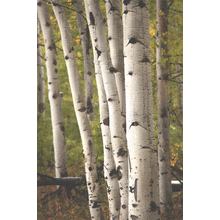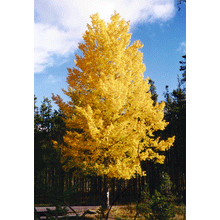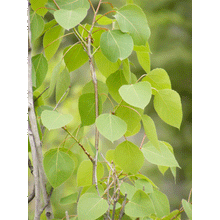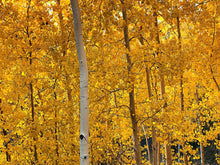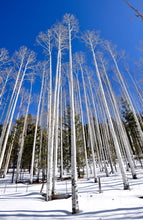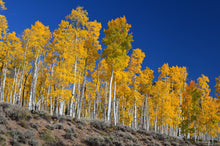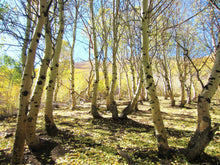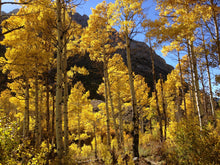
Populus tremuloides
-
Grow your own Quaking Aspen, a cherished icon of America's High Country!
- 100% guaranteed
- Seed-grown on California's Redwood Coast
- Transplanting and care instructions included
 |
Moisture Medium |
 |
Cold Hardiness -60°F |
 |
Light Full Sun |
 |
Size 20 – 80' tall / 10 – 30' spread |
 |
Lifespan 200 yrs |
 |
Growth Rate Fast Growing |
 |
Drought Tolerance High |
 |
Wind Resistance High |
Quaking Aspen: A Cherished Icon of North America's High Country
A member of the willow family, Aspen is the most widespread tree on the North American continent, yet its beauty is anything but common. In autumn, Aspens are nothing less than stunning – gilded with brilliant golden leaves, perpetually trembling and splashing sunlight in every direction. Aspens are fast growers, and can survive almost anywhere – so long as they get ample sunlight. Aspens typically grow to around 80 feet in height, and usually live for about a century.Populus tremuloides, also known as “Golden Aspen,” “Quaking Poplar,” and “Small-toothed Aspen,” among other common names, makes its glowing presence known throughout all the great Mountain systems of the United States and Canada. The species’ immense range spreads all the way down into the mountain ranges of Mexico, as well. Every account of early western exploration includes mention of the remarkable beauty of the Aspen groves encountered in the mountains. As one naturalist wrote: “Where the deer bound, where the trout rise, where your horse stops to slather a drink from icy water while the sun is warm on the back of your neck, where every breath you draw is exhilaration — that is where the Aspens grow.”
Aspens grow quickly, and are often the first “pioneer” species to re-populate burned over or otherwise exposed areas of the forest. As a population, they chase sunlight, and are nearly indifferent to changing soil conditions. Likewise, they are a “vagabond” species, which will migrate as other vegetation competes and crowds in for sunlight.
Aspens are especially prolific in high, dry, cool places, commonly close to clean, rushing water, where they form open, sunny groves and regenerate in pure stands, primarily from basal sprouting. In some regions of the far North, Aspens are the only hardwood trees present among the conifers, making them particularly spectacular as they sparkle brilliantly in gilded contrast with the otherwise monochromatic evergreens.
Aspens are typically smallish trees, around 40 feet tall with trunk diameters under two feet across. Their trembling, ever-moving leaves are pale green in spring and summer, burnishing to radiant gold in autumn. Aspen bark is smooth and the color of white-ash. Older trees have bark that’s nearly black at the base, turning to smooth mottled gray higher up the trunk. The bark has analgesic and anti-inflammatory properties, making it a highly valued source of medicine for Native American peoples.
In addition to lending beauty and elegance to the North American high country and providing medicine to indigenous peoples for centuries, Aspen also contribute valuable wildlife habitat and food for a wide variety of animals. Some estimate that as many as 500 different animal and bird species rely on Aspens for forage and shelter. Of all these Aspen fans, it is the beaver who is the true Aspen worshipper. For food and construction materials, the Quaking Aspen is clearly the beaver’s favorite tree. Humans also have a great appreciation for Aspen’s usefulness — it is one of America’s leading pulpwood trees.
The American National Champion Quaking Aspen tree resides in the State of Michigan. The tree is 109 feet tall, with a trunk diameter of nearly 40-inches.
Populus tremuloides, Quaking Aspen, is a beautiful, useful, historically important, and truly iconic species that can be cultivated virtually anywhere — including your yard, garden, deck, or patio!
About Jonsteen's Seedlings
All of our trees are seed-grown at our nursery on California's Redwood Coast, which is inspected monthly and licensed by the California Department of Agriculture. Trees can provide a natural barrier against high winds, temperatures, noise pollution and soil erosion, all while benefiting local air quality, wildlife and property values — a Jonsteen seedling will only grow in value and beauty!
About Jonsteen's 100% Guarantee
All of our trees are guaranteed to arrive healthy and in good condition. If your tree perishes despite your honest efforts, we will be happy to replace it with a small-sized seedling for just the cost of shipping/handling. You can learn more about our guarantee and tree replacement policy here.
Seedling Size Chart: Small
Due to the dynamic nature of actively growing trees, as well as the tremendous variation between species’ growth rates, we rely on the cubic volume of a seedling’s root mass to determine its “size” (Small / Medium / Large / XL). Within each size there is minor variance — the dimensions provided here represent the category minimum. If exact measurements are essential, please contact us about current stock.










